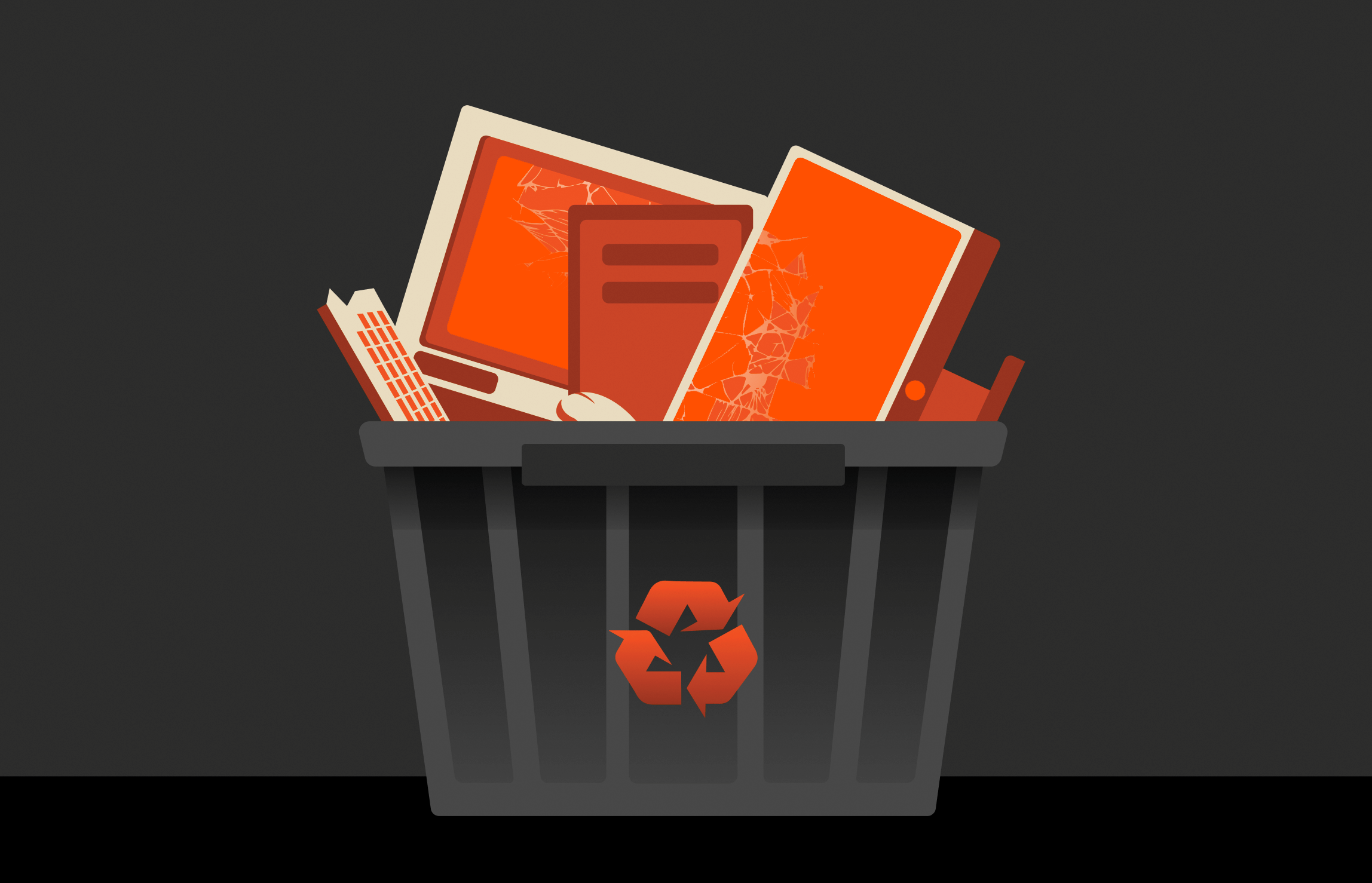Summary
In a world where the battle against e-waste in landfills grows increasingly critical, sustainability and circular economy principles will be needed significantly reduce e-waste, conserve resources, and create a more sustainable future. This article explains how.
Recycling is vital for reducing waste, conserving resources, and mitigating environmental harm. Almost everyone recycles in some way now, and recycling has become a part of our everyday lives.
But we still have a long way to go.
While recycling programs have effectively diverted materials like paper, glass, and aluminum from landfills, there are challenges in other areas. Some markets lack regulations for effective recycling, leading to valuable resources ending up in landfills. A 2022 report revealed that the recycling rate in the US has fallen to 5-6%.
Electronic waste, or e-waste, is especially concerning as it’s the fastest-growing waste stream globally. There are currently over 347 million metric tons of unrecycled e-waste on the planet. While many components of electronic devices are recyclable, the recycling rate for e-waste is relatively low. Many markets have limited or no regulations around e-waste, and in some countries, less than 20% of e-waste is properly recycled.
“There are numerous environmental hazards from not disposing of this stuff, not just to the environment but to humans,” said Nathan Hall, Vice President of Asia Pacific & Japan, Pure Storage, in a recent interview. “A lot of the stuff is toxic, especially if it’s not disposed of correctly. And ultimately, there’s also the impact of, ‘A lot of this stuff can be reused.’”
In this blog post, we’ll delve into the world of recycling, e-waste, and the role of Pure Storage in promoting sustainability through a circular economy.
Read the white paper: Efficient IT Infrastructure Saves More Than Just Energy Costs
E-waste Risks and Challenges
E-waste encompasses any discarded electronic devices that have reached the end of their useful life. This category includes items such as smartphones, computers, televisions, monitors, printers, and copiers that are no longer functional, have suffered significant damage, or have become obsolete to the point where they can’t be updated for compatibility with modern technology.
In our daily lives, we heavily rely on electronics. Whether it’s working on a laptop, communicating via smartphones, or using tablets for various tasks, these electronic devices eventually wear out or become obsolete. When this happens, what do we do with them? Surprisingly, many people are unsure about the proper disposal of electronic waste, which poses a significant threat to the environment, impacting land, water, and air quality.
E-waste is on track to double its annual generation between 2014 and 2030, with estimates indicating that annual worldwide e-waste generation could reach 67 million tons by 2030.
Here are some other e-waste factors to consider:
Lack of Awareness
A survey conducted among Generation Z and Millennials revealed that 60% of respondents from these age groups were unfamiliar with the concept of e-waste, while 57% were unaware that these discarded electronics contribute to environmental pollution. Paradoxically, despite their willingness to recycle plastics, glass, metals, and paper (reported by 90% of respondents), studies indicate that only 37% of these individuals actively contribute to addressing the e-waste problem. This highlights the urgent need for improved public awareness and accessible recycling options for electronic devices.
Inadequate Recycling Rates
Global e-waste recycling statistics are discouraging, with just 17.4% of e-waste being recycled in 2019. Proper e-waste recycling involves sending discarded devices to specialized facilities capable of disassembling them to salvage reusable components. These facilities also ensure the secure destruction of data on these devices before processing them through large grinders that break them down into recyclable materials such as metal, glass, and plastic.
Different materials are further segregated based on their type and subsequently processed for reuse. Effective e-waste recycling can recover valuable raw materials like gold, aluminum, silver, copper, and palladium, which can be used to manufacture new products. However, in the United States, only 15% of e-waste is recycled, despite being the second-largest global producer of e-waste. This discrepancy underscores the need for improved e-waste recycling practices in the US, especially in regions without established e-waste regulations.
Regional Disparities
South Asia leads the world in e-waste generation, producing 22.6 million tons, followed by the Americas at 11.9 million tons. Europe (10.9 million tons), Africa (2.6 million tons), and Oceania (0.6 million tons) complete the list of significant contributors.
However, when considering “per capita” rates, Europe tops the list with 35.6 pounds per person, followed by Oceania with 35.4 pounds. The Americas (29.2 pounds), Asia (12.3 pounds), and Africa (5.5 pounds) follow in per capita e-waste generation.
Europe may generate the most e-waste per capita, but it also leads the world in e-waste recycling. Almost 43% of Europe’s e-waste is responsibly recycled, surpassing Asia (11.7%) and the Americas (9.4%).
Asia is seen as one of the worst contributors to e-waste—which is not surprising given that it’s also a global tech hub.
“I think we want to not just be the technology capital of Asia we want to be the sustainable technology capital of Asia,” Nathan said.
Recycling IT Equipment and Embracing the Circular Economy
Recycling IT equipment offers a promising solution to the growing e-waste problem. By recycling, we can recover valuable materials like metals, plastics, and rare earth elements, reducing the need for resource extraction and the associated environmental impact. Furthermore, responsible recycling ensures that hazardous materials are disposed of safely, mitigating harm to the environment and human health.
At the heart of the solution lies the concept of the circular economy. The circular economy is a regenerative economic model designed to minimize waste and maximize the longevity of products and materials.
A circular economy promotes the following principles:
- Design for longevity: In a circular economy, products, including IT equipment, are designed with durability and longevity in mind. This means using high-quality materials, modular designs, and repairability to extend the lifespan of electronic devices.
- Reuse and refurbishment: Instead of disposing of old IT equipment, a circular economy encourages the reuse and refurbishment of devices whenever possible. This not only reduces e-waste but also provides affordable technology access to a broader population.
- Responsible disposal: In cases where recycling or refurbishment is not viable, proper disposal is essential. A circular economy emphasizes the safe and environmentally sound disposal of electronic waste, preventing contamination and harm.
- Innovation: The transition to a circular economy stimulates innovation in recycling technologies, sustainable materials, and product design. This fosters a culture of continuous improvement.
“Bring it to an actual recycling center – to a certified e-waste program. That guarantees that it gets disposed of properly, including that the data you have on it is not compromised.” – Nathan Hall, Vice President of Asia Pacific & Japan, Pure Storage
Recycling IT equipment in a circular economy not only conserves valuable resources but also offers significant economic opportunities because it generates jobs in collection, refurbishment, recycling, and innovation. It can also present internal growth and promotional opportunities through companies’ ESG programs. Embracing the principles of the circular economy holds the key to addressing the challenges posed by e-waste while unlocking economic and environmental opportunities.
As technology continues to advance, it’s imperative to prioritize responsible e-waste management, design for longevity, and promote a circular economy mindset.


How Pure Storage Supports Recycling, Sustainability, and a Circular Economy
Pure Storage has always focused on doing what’s right. In an era where technological innovations drive rapid obsolescence and contribute to the growing problem of e-waste, Pure Storage has emerged as a trailblazer in the fight against this environmental challenge.
Here’s how Pure Storage supports global recycling efforts and a circular economy:
1. Evergreen//One
Evergreen//One™ is a paradigm shift in the world of IT infrastructure. At its core, Evergreen//One ensures that Pure Storage products are always modern and equipped with the latest software upgrades. This forward-thinking approach ensures that devices remain relevant and functional over extended periods, significantly reducing the need for constant replacement and the consequent e-waste that results from outdated electronics.
2. FlashArray//E
Pure Storage has embedded sustainability within its product DNA through the integration of built-for-flash software and DirectFlash® technology. This combination delivers unparalleled reliability, extended service lifetimes, and a remarkable three times the industry average SSD reliability. By significantly enhancing product durability and longevity, Pure Storage directly addresses the e-waste issue at its source. The Pure//E™ Family is the perfect replacement for unsustainable spinning rust. FlashArray//E™ reduces e-waste by up to 85% thanks to enhanced product durability and fewer hardware upgrades.
3. E-waste reduction initiatives
E-waste reduction initiatives can help to keep metric tons of e-waste from ending up in landfills each year through several strategies:
- Consolidating storage: By consolidating storage onto fewer, larger DirectFlash media housed in existing racks, Pure Storage optimizes resource utilization, reducing the need for frequent hardware replacements.
- Swapping controllers: Rather than discarding entire storage systems, Pure Storage swaps new controllers into the same physical chassis, further extending the lifespan of the hardware.
- Partial reuse of controllers: Returned controllers find a second life in Pure’s internal lab infrastructure, where they’re used for testing, analysis, and long-term reliability studies, effectively reducing e-waste.
- Right-sizing equipment: We can right-size the equipment necessary to meet each particular SLA, in some cases repurposing previously used equipment. This extends the effective service lifetimes of a physical piece of equipment and significantly reduces e-waste. The useful life of our products is typically two to three times that of competing storage.
4. Providing simple, sustainable solutions
Finally, Pure Storage supports waste reduction by providing simple, sustainable data storage solutions.
As an example of what we help our partners and customers achieve in sustainability, let’s look at Innovapost, winner of the 2023 Pure Good Sustainability Award. Innovapost uses Wipro as its managed service provider, running FlashStack® from Pure Storage and Cisco for greater sustainability and energy savings.
With Pure Storage and Wipro, Innovapost has already been able to:
- Shrink its data center storage footprint by 97%
- Reduce carbon emissions by more than 93%
- Avoid complex upgrades with the Pure Storage® Evergreen//Forever™ solution’s three-year, non-disruptive, auto-refresh of storage hardware
- Respond to changing business needs quickly to allow more creativity and innovation thanks to the secure and reliable infrastructure built on FlashStack
Consider this one final fact: Approximately 97% of Pure arrays deployed six years ago are still in service today, thanks to our Evergreen//Forever program.
Conclusion
In a world where the battle against e-waste grows increasingly critical, Pure Storage stands out as a beacon of sustainability and circular economy principles. Through initiatives like Evergreen//One and innovative technologies like DirectFlash, we’ve demonstrated that it’s possible to significantly reduce e-waste, conserve resources, and lead the way toward a more sustainable future in the IT industry.
Written By:
Our Commitment
Read our annual ESG Report for an update on our environmental, social, and governance journey.








